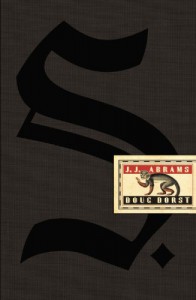

This is probably the most unique reading experience I’ve had in a long time. Rather than a traditional novel, S. is presented as an old copy of the fictional book “Ship of Theseus” by “VM Straka” from 1949. The book has a period appropriate cover design, and is faux-aged to look like an old library book, complete with old stamps, yellowed pages, and even fake stains. The margins of the book are filled with the “handwritten” notes of two previous readers, Jen and Eric; the ink colors change with time, and there are even smudges and cross-outs. Tucked into the pages are various documents including photocopies, photos, letters, postcards, and (my personal favorite) an actual napkin with a “hand-drawn” map. The attention to detail is absolutely amazing, and the story is pretty good too.
“Ship of Theseus” itself is the meandering, surreal story of a man, “S”, who find himself washed up in an unnamed city with no memory or knowledge of his identity. He is soon shanghaied aboard a creepy ship with no apparent captain and a strange crew whose members have sewn their mouths shut. When S. tries to escape the ship, he is then caught up in a struggle against the corrupt Vevoda, a business magnate with an unstoppable weapon of mass destruction.
The margin notes tell the story of two readers trying to unravel the mystery surrounding the reclusive author VM Straka, and his apparent involvement in major historical events. Jen, a college senior, finds the copy of “Ship of Theseus” left behind in the college library by Eric, a disgraced graduate student. Seeking an escape from her impending graduation and recent breakup, Jen begins delving into the Straka mystery, corresponding with Eric in the margins of the book. As the two uncover more information about the mysterious Straka, they find themselves possibly drawn into a conflict decades and maybe even centuries old.
Jen and Eric’s story jumps around a bit, as the notes are not always in chronological order. Some details and events are also only alluded to, leaving the reader to fill in some of the gaps. There are, however, additional codes in the book to solve, and in-universe websites, so the story doesn’t necessarily end with what’s in the book.
The reading order is completely open, but I found it easiest to start by reading through “Ship of Theseus” on its own, then going back and reading the margin notes. The ink colors denote different time periods; Jen’s notes start out in blue ink, with Eric’s responses in black. The second set are in orange and green, the third in purple and red, and the most recent all in black. It’s probably best to read all the earlier, blue and black notes first, then going back and approaching each set in turn. The inserts are mentioned in text by Jen and Eric at their appropriate points in the story; it helped me to make a list of the insert locations beforehand, so I could easily find the appropriate document.
S. is just a lot of fun, and is a must read for anyone who likes unique, experimental reads.





